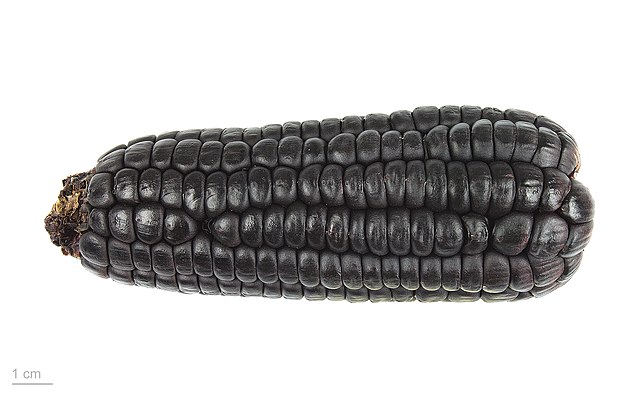Purple Corn:
Purple Corn: What is it?, History, cultivation, nutritional value, uses, recipes, and more...
Purple corn is a genetic mutation of corn and originates from South America. It is one of the richest sources of anthocyanins and is the star ingredient in well-known Peruvian foods: purple pudding (“mazamorra morada”) and purple corn drink (“chicha morada”).
What is Purple Corn?
Purple corn is a collection of varieties of Zea mays, maize, originating from the Peruvian Andes. It is characterized by being the only one in the world to possess purple husks, bracts, and grains due to a natural pigment called Anthocyanin, which also gives color to fruits like blueberries, cherries, or raspberries. The different colorations of purple corn varieties are associated with the concentration, type, and location of bioactive compounds such as carotenoids and anthocyanins they contain (Győri, 2017).
Various types of purple corn primarily grow in the Andes of Peru, Bolivia, Colombia, and Ecuador, although they also have a presence in Costa Rica and Mexico. All these maize varieties are derived from an ancestral line called k’culli (a Quechua term), which is still cultivated in Peru, Bolivia, and Argentina. Its color is due to anthocyanins, a water-soluble and natural pigment.
This corn features a solid and upright stem that can reach between 60 cm and 4 meters, depending on the variety. At the tip, it bears a plume-like flowering structure, and its large elongated leaves produce the ears that later develop into corn cobs filled with rows of grains.
History of Purple Corn
Purple corn is an ancestral variety of the Zea Mays grass, originating from the South American Andes, where its consumption dates back at least 2,500 years. In pre-Hispanic Peru, it was known as “oro,” “sara,” or “kulli sara.” It was also cultivated in Yucatán and by indigenous tribes such as the Hopi and Navajo in the United States. However, it is in Peru where its cultivation has been most widespread, and it is used as an ingredient in emblematic dishes like “mazamorra morada” and “chicha morada.”
It is known that this superfood has been depicted in various ceramic objects from the Moche culture dating back over 2,500 years. The Incas also used it as both food and a raw material for obtaining textile dyes.
Various chroniclers have reported that during the colonial era, “mazamorra morada” emerged as a dessert that combined purple corn with sweet potato flour, sugar, and a variety of dried fruits brought from Spain. The popularity of this dessert led to the expression “limeño mazamorrero,” which became well-known thanks to the writer Ricardo Palma, author of the famous “Traditions Peruanas.”

Common Name of Purple Corn
| Spanish | choclo morado, elote morado, maíz negro, maíz morado peruano, elote negro o maíz violeta. |
| Costa Rica | Maíz pujagua |
| English | Andean purple corn, blue corn o purple corn |
Scientific Name of Purple Corn
Zea Mays
Taxonomy of Purple Corn
| Kingdom | Plantae |
| Subdivision | Magnoliophyta |
| Class | Liliopsida |
| Subclass | Commelinidae |
| Order | Poales |
| Family | Poaceae |
| Subfamily | Panicoideae |
| Tribu | Andropogoneae |
| Subtribu | Tripsacinae |
| Gender | Zea |
| Specie | Zea mays |
Synonymy of Purple Corn
- Zea alba Miller
- Zea amylacea Sturtevant
- Zea amylesaccharata Sturtevant
- Zea cryptosperma Bonafous
- Zea curagua
- Zea erythrolepis
- Zea glumacea Larrañaga
- Zea indentata Sturtevant
- Zea indurata Sturtevant
- Zea japonica van Houtte
- Zea macrosperma Klotzsch
- Zea mucronata Vilmorin
- Zea rostrata Bonafous
- Zea saccharata Sturtevant
- Mays vulgaris Seringe
- Mays zea Gaert.
- Thalysia mays Kuntze
- Zea americana Mill.
- Zea segetalis Salisb.
- Zea tunicata (St-Hilaire) Sturtevant
- Zea vulgaris Miller.
Etymology of Purple Corn
The term “Zea” comes from “zēa,” derived from the Greek ζειά (“zeia”), which refers to spelt, a plant similar to wheat mentioned by Pliny. The name used by Linnaeus for corn. The specific term “mays” is derived from “maíz,” the Spanish word for corn.
The word “maíz” entered the Spanish language as a loanword from the Taíno language, where it means literally “that which sustains life.” In the Andes, it is also known as “sara,” a Quechua word.
Habitat of Purple Corn
- Habitat
Purple corn requires a temperature range of 25 - 30 °C and should not exceed 40 °C to prevent the plant from developing poorly (Aysanoa, 2010).
Preferably, it should be cultivated at altitudes between 1,200 to 4,000 meters above sea level, in deep soils with a loamy to loam-clay texture, good moisture retention capacity, and without drainage problems or excess moisture, as this hinders pigment accumulation in the cobs.
This corn is harvested when it has an approximate moisture content of 18 to 20%. After harvesting, the corn is usually dehydrated to stabilize the grains and increase their shelf life, reaching moisture values between 13 to 14% (Betrán et al., 2000). The grains can then be sold directly or their value can be enhanced through milling and sieving to obtain different types of flour.
Geographical Distribution of Purple Corn

Ayacucho, Apurímac, La Libertad, Lima, Ica, Arequipa, Moquegua, Huánuco, Ancash, Cajamarca
Seasonal Availability of Purple Corn
- April, November, December
Varieties of Purple Corn
-
Nationally
Improved Purple (derived from Caraz), Caraz Purple, Arequipeño (Traditional variety), Purple Cusco, Junín Black
Nutritional Value of Purple Corn
Due to its high content of anthocyanins (cyanin-3-glucose C3G) and phenolic compounds, purple corn is a powerful natural antioxidant and anticarcinogenic. The average anthocyanin content of fresh purple corn is 16.4 mg/gram, higher than that of fresh blueberries, according to a study by the University of Texas.
Furthermore, this corn has an enriched composition of phytochemicals that have positive effects on the body, such as neutralizing free radicals and acting as an antimutagenic agent. It also helps lower cholesterol, combat diabetes, and prevent atherosclerosis.
Purple corn is recommended for its anti-inflammatory effect (Zhang et al., 2019) and is used to aid tissue regeneration and collagen formation, as well as maintaining low blood pressure. It is known to help the body synthesize fatty acids, which is particularly beneficial for people with diabetes (Zhang et al., 2019; Ferron et al., 2020) and those who suffer from obesity.
It also improves visual acuity by regenerating rhodopsin, a protein found in the rods of the retina. Additionally, it reduces the risk of cataracts and macular degeneration, the leading cause of blindness in the elderly.
Purple corn is characterized by having higher protein and mineral content than other types of corn. Moreover, it is valued for its high content of flavonoids, which explains its elevated antioxidant capacity compared to non-colored maize (Betrán et al., 2000).
Finally, purple corn provides phosphorus, iron, beta-carotene (a precursor to vitamin A), vitamin B2 and B3, and vitamin C, with its richness in fiber standing out.
Health Benefits of Purple Corn
Purple corn stands out for its significant contribution of anthocyanins, which have been shown to promote the reduction of blood pressure in hypertensive individuals and help increase the total antioxidant capacity of the blood.
Contraindications or Side Effects
Purple corn should be consumed in moderation in the following cases:
It is contraindicated for pregnant or lactating women as it can cause spontaneous abortions due to its stimulation of blood circulation.
In case of allergies, due to its high starch content, it can cause allergies with redness or rashes.
| 10 Porciones por Kilogramo | |
| Tamaño de porción | 100g |
| Cantidad por porción Calorías |
355 |
| Cantidad por 100g | |
| Energía | 1,487 kJ |
| Grasa Total | 3.4 g |
| Sodio | ● |
| Carbohidratos totales | 76.2 g |
| Carbohidratos disponibles | ● |
| Fibra Dietaria | ● |
| Proteínas | 7.3 g |
| Calcio | 12 mg |
| Fósforo | 328 mg |
| Zinc | ● |
| Hierro | 0.20 mg |
| Potasio | ● |
| Agua | 11.4 g |
| Cenizas | 1.7 g |
| Vitamina A | 8 μg |
| Tiamina (B1) | 0.38 mg |
| Riboflavina (B2) | 0.22 mg |
| Niacina (B3) | 2.84 mg |
| Vitamina C | 2.10 mg |
| Acido Fólico (B9) | ● |
| β-Caroteno | ● |
| Fuente: Tablas peruanas de composición de alimentos – Centro Nacional de Alimentación y Nutrición – Ministerio de Salud – Perú | |
Derived Products and Consumption Forms of Purple Corn
Uses of Purple Corn
The primary use of purple corn is culinary, although it also possesses significant medicinal properties and a long history as a ritual element in pre-Columbian Peruvian cultures.
- Culinary
- Medicinal
Culinary Use of Purple Corn
In Peru, there are two main ways to consume purple corn: in the beverage called "chicha morada" and in the purple corn compote known as "mazamorra morada."
Internationally, purple corn serves as an ingredient in desserts such as puddings, cupcakes, crepes, and others. It is also used as a means of partially substituting other flours, like wheat flour, with organic purple corn powder (which has the advantage of being gluten-free).
Typically, it is recommended to consume 5 to 10 grams per day and can be consumed in juices, desserts, jams, yogurt, pasta, tamales, etc. It is also exported to the United States and Europe, where it is used as a natural colorant in the food and beverage industry.
Medicinal Use of Purple Corn
The characteristic colorant, cyanidin-3-beta-glucoside, is a potent antioxidant with proven medicinal properties worldwide, including:
- Promotes cholesterol reduction and lowers blood pressure
- Stabilizes and protects artery capillarity
- Combats obesity and diabetes
- Prevents cancer Furthermore, the flour is used to make therapeutic poultices for eczema, sores, or bruises.



